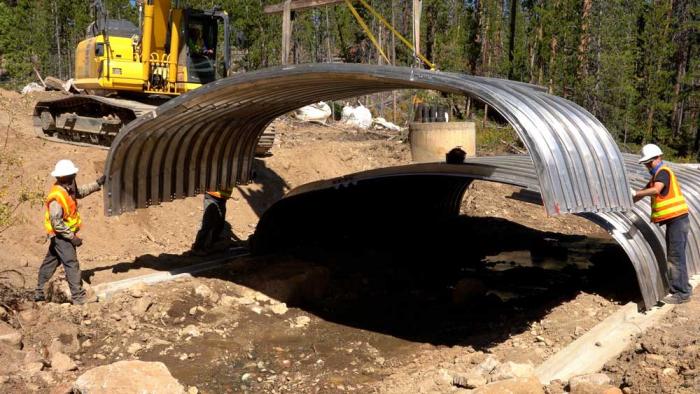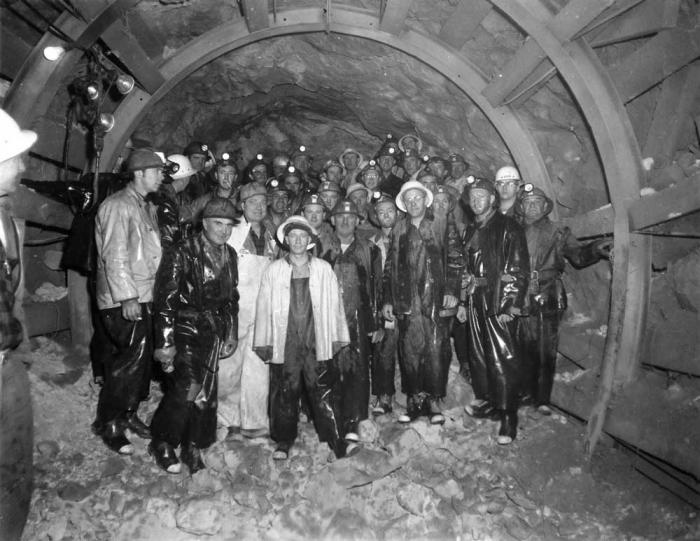Major $2.6 billion, 10-year investment on tap
From protecting customers from the risk posed by old lead service lines to preparing to meet the challenges of the future, Denver Water takes a long-term view when planning for the future.
And the utility has been recognized nationally for its work, by peer utilities as well as by federal officials.
Denver Water in early October was recognized — for the second time — by the Association of Metropolitan Water Agencies, a group representing the largest publicly owned drinking water suppliers in the United States.
At the association’s annual meeting, held in Denver this year, Denver Water received the group’s 2021 AMWA Sustainable Water Utility Management Award for its work to curb carbon emissions, increase its use of renewable energy and protect the environment and its communities.
Denver Water’s groundbreaking Lead Reduction Program was recognized by the national utility association and also was highlighted by leaders at the Environmental Protection Agency earlier this year for the jobs it created and its unique approach to diverse communities.
Replacing all the old, customer-owned lead service lines in Denver Water’s service area at no direct cost to the customer will take 15 years to complete, and it’s just one of the major undertakings that make up the utility’s 10-year forecast for an estimated $2.6 billion investment into the system that supports about 25% of the state’s population, including Colorado’s capital city.
About 90% of the forecast investment over the next decade is dedicated to large projects and regular annual inspection and maintenance programs that protect customers, position Denver Water for the future and continue regular monitoring programs for infrastructure already in place. The remaining investment focuses on maintenance and improving the resiliency of the system.
Read how customers help invest in their water system.
Here’s an overview of some of Denver Water’s work:
Lead Reduction Program
A major part of Denver Water’s investment forecast is the Lead Reduction Program, which launched in January 2020.
The program will reduce the risk of lead getting into drinking water by replacing, by the end of 2034, an estimated 64,000 to 84,000 old, customer-owned lead service lines put in place decades ago across its service area.
It’s the biggest public health campaign in the utility’s history and through the end of September, more than 9,000 lead service lines have been replaced.
Households enrolled in the program are provided with water pitchers and filters certified to remove lead. Filtered water should be used for drinking, cooking and preparing infant formula until six months after the lead service line is replaced.
The water Denver Water delivers to customers is lead-free. Learn more about how lead can get into drinking water as it passes through customers’ lead service lines and indoor plumbing that contain lead.
In March 2020, Denver Water also raised the pH of the water it delivers to customers to help reduce the risk of lead getting into water as it passes through customers’ internal plumbing that may contain lead.
Northwater Treatment Plant
Work on Denver Water’s new, state-of-the-art Northwater Treatment Plant next to Ralston Reservoir north of Golden passed a major milestone over the summer when concrete floors were poured for the plant’s two massive storage tanks.
Each of the tanks, which will be mostly buried underground when complete, will be capable of holding 10 million gallons of clean, safe drinking water.
“This new plant will use renewable energy in its operations and will feature advanced water filtration and disinfection technology to help us meet the water quality challenges of the future,” said Nicole Poncelet-Johnson, director of water quality and treatment at Denver Water.
Read about Denver Water’s North System Renewal Project, a $600 million, multiyear investment that includes the new treatment plant.
The Northwater plant, scheduled for completion in 2024, will include 14 buildings and be able to treat 75 million gallons of water per day. It also has the capability to be expanded to treat 150 million gallons per day in the future if needed.
A new water quality laboratory
In September, work on the Hydro building at the National Western Center, part of which will house Denver Water’s new water quality laboratory, passed a milestone when the building’s final steel beam was lowered into place.
Locating Denver Water’s water quality laboratory in the midst of Colorado State University’s new campus ensures the utility’s water experts will be working near researchers, scientists and others tackling issues surrounding water, agriculture and public health that are important to the metro area, state and region, according to Poncelet-Johnson.
Learn more about Denver Water’s partnership with Colorado State University at its Spur campus.
“We live in a dry, arid region that’s not getting any wetter. So we want to participate in research that will help us understand how we can help farmers, the public and our customers thrive through the changes we’ll experience in the next several decades,” she said.
Water storage
The investment plan also includes the Gross Reservoir Expansion Project, which is working through the final stages of the legal process before beginning construction.
Expanding Gross Reservoir, as was anticipated when the dam was constructed in the 1950s, will provide greater balance between Denver Water’s north and south collection areas.
Get more details about the history behind the Gross Reservoir Expansion Project.
Denver Water also expects to complete work in 2022 on construction at its Hillcrest site in southeast Denver where three, new treated-water storage tanks and a new pump station are being built.
And the utility is continuing work converting old gravel pits into downstream reservoirs north of Denver along the South Platte River. The reservoirs improve the system’s diversity, flexibility and sustainability because they can store water for release when needed by downstream water users, allowing Denver Water to store extra water in its mountain reservoirs upstream from Denver.
Ongoing investments
Denver Water is continuing its investment in replacing its water mains under streets and installing new ones where needed. The utility has more than 3,000 miles of pipe in its system, enough to stretch from Seattle to Orlando.
Check out this big pipe project along parts of Federal Boulevard in Denver.
The utility is working toward a goal of replacing 1% of its installed water mains every year, or more than 145,000 feet of pipe.
Denver Water also is continuing to invest in ongoing monitoring, inspection and protection programs that keep tabs on its larger conduits and smaller pipes in a variety of ways.
For example, on a pipeline that crosses north Denver, the utility has used electromagnetic inspection technology as well as an acoustic fiber optic monitoring system. Both technologies help monitor the strength of prestressed concrete cylinder pipes used to transport water.
Denver Water’s cathodic protection program aims to reduce corrosion on pipes made of steel and ductile iron. The protection program installs a sacrificial piece of metal, called an anode, to the pipe that diverts corrosion activity away from the pipe.
And the utility works with experts throughout the utility industry to improve technology.
In 2020, Denver Water tested the “PipeDiver,” a device designed to move through delivery pipes with the flow of water and collect information about the pipe from the inside.
Denver Water is investing in forest health projects designed to protect mountain watersheds, the locations snow and rain pass through before flowing into the rivers and streams that fill Denver Water’s storage reservoirs.
The utility is a partner in the From Forests to Faucets program with the U.S. Forest Service, the Colorado State Forest Service and the Natural Resources Conservation Service.
In 2018, a fuel break saved $1 billion worth of homes and infrastructure from a wildfire.
Since 2010, the From Forests to Faucets partners have invested nearly $66 million in forest health projects in Boulder, Douglas, Grand, Jefferson, Park, Summit and Teller counties. Funds have helped plant over 1.5 million new trees in burn areas and treat about 120,000 acres of forest land as of 2021.
Being financially responsible
Denver Water has a long been proactive with maintaining and improving its vast network of dams, pipes, canals and treatment plants and thinking about what’s needed in the future.
“If you look back at Denver Water’s history, they planned and made really smart decisions 100 years ago that allowed us to build an infrastructure that supports 1.5 million people,” said Poncelet-Johnson, speaking about the new water quality laboratory — and Denver Water’s overall focus on the long-term.
“It’s our job to do the same for the next 100 years, to develop the research on how to use our resources wisely to support future generations.”



